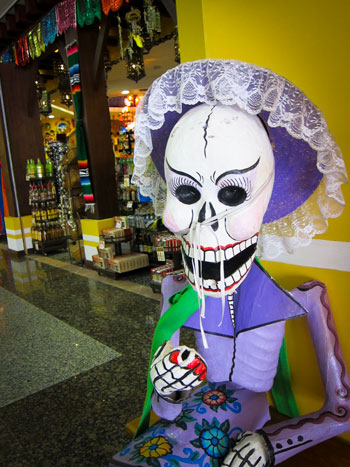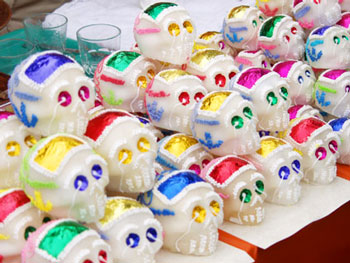Dia de los Muertos: Day of the Dead is a Celebration of Life

Naming a holiday “The Day of the Dead” (El Día de los Muertos) doesn’t sound like a recipe for joyful celebration. But indeed, this day of remembrance is a time of happy family sharing and activity, for it’s when Mexicans and some people of other Latin cultures lovingly—and colorfully—recall the relatives that have passed.
The tradition is pre-Columbian, but has blended elements from the Spanish conquest as well. Some indigenous peoples believed that souls do not die, but continue to rest in Mictlan, a sacred place. Thus, contemporary Mexican families recognize and ritualize the continuance of the generations through the past. Though Mexico celebrates November 2nd as the Day of the Dead (or All Souls’ Day), preparations for—and the expression of—the occasion begin as early as mid-October, with November 1 being observed as the day to celebrate the souls of children, the Angelitos.
The Souls Are Well-Fed
Though the prayers offered for the souls passed are solemn, little else about the ceremonies is: humorous depictions of skeletons abound, including those representing pets. These spectral figurines can be life-sized or larger, or small enough to fit on the family altars that are found in many Mexican homes during the period. Skulls in particular are popular, often made of candy, and often with the names of the deceased written on them. Family altars will also have photos, candles, mementos and the favorite foods and drinks of the deceased as well.

In October, bakeries will start selling Pan de Muerto, Bread of the Dead, often adorned with strips of dough to represent bones; this bread is often left at gravesides, which are cheerfully decorated by family members. During the third week of October, the cempasúchil flowers (the “flower of the dead”) are harvested, and their orange petals can be seen adorning many ritual places.
Many towns will have ceremonial gatherings in graveyards on November 2, with all attending dressed in finery. Sometimes there will be all-night candlelight vigils, often accompanied by readings of the Catholic rosary. However, the spirit of these gatherings is more festive than somber. Some towns and villages have unique celebrations all their own, with ritual dances or Mariachi bands or particular styles of dress. Los Cabos too, has a full range of Day of the Dead expression. Watch out for those skeletons!
By Tom Bentley
